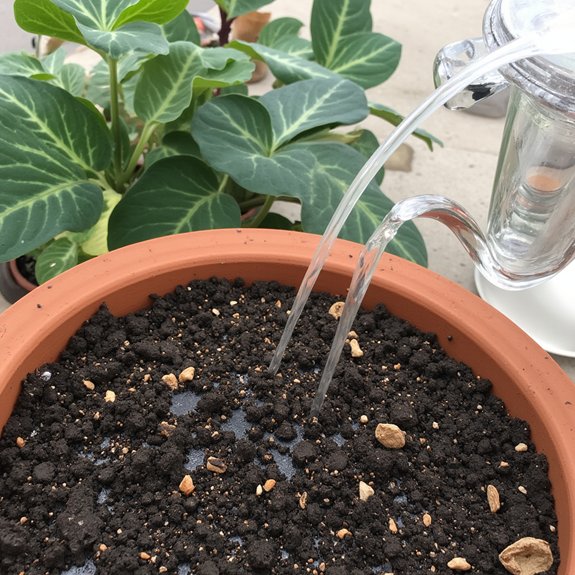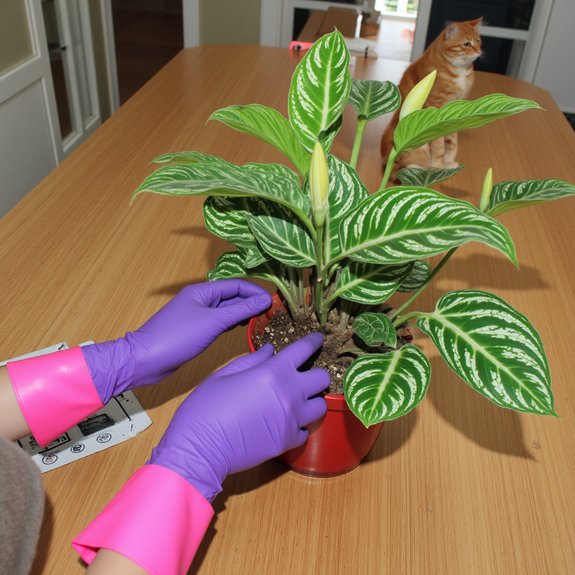You’ve probably admired Anthurium Crystallinum’s stunning velvet leaves and dramatic white veining in photos, but growing this tropical beauty successfully requires more than wishful thinking. This isn’t your typical houseplant that’ll forgive neglect or adapt to any corner of your home. Getting the care right means understanding exactly what this rainforest native demands, and there’s a specific method that separates thriving specimens from disappointing failures.
Contents
- 1 Understanding Anthurium Crystallinum: A Tropical Treasure
- 2 Light Requirements: Finding the Perfect Bright Spot
- 3 Watering and Soil Essentials for Healthy Growth
- 4 Temperature and Humidity: Creating Tropical Conditions
- 5 Safety Considerations: Toxicity and Proper Handling
- 6 Purchasing, Planting, and Propagation Techniques
- 7 Troubleshooting Common Issues and Maintenance Tips
Understanding Anthurium Crystallinum: A Tropical Treasure

When you encounter Anthurium crystallinum for the first time, you’ll immediately understand why plant collectors consider it a prized possession. This Central and South American native showcases remarkable plant aesthetics with heart-shaped leaves reaching 18 inches across. The velvety texture, coppery-red undersides, and silvery-white veining create stunning visual appeal.
You’ll notice fascinating growth patterns as your plant matures. Young leaves emerge with different coloration, gradually developing their signature appearance. The genus Anthurium offers unique characteristics, but crystallinum stands out with its rarely-seen skinny flowers resembling Peace Lily blooms, though foliage remains the main attraction.
Light Requirements: Finding the Perfect Bright Spot
Since Anthurium crystallinum evolved beneath the rainforest canopy, it craves bright, indirect light that mimics those dappled conditions. Position your plant near east-facing windows where morning sun filters gently through, or use sheer curtains to soften harsh rays.
Watch your plant’s leaf placement for clues about lighting success. Leaves stretching toward windows indicate insufficient light, while browning edges suggest too much direct exposure. You’ll know you’ve nailed the perfect spot when new leaves emerge with vibrant veining and maintain their velvety texture.
Avoid south-facing windows unless you’ve got solid indirect sunlight protection—those intense rays will scorch those gorgeous leaves.
Watering and Soil Essentials for Healthy Growth

While Anthurium crystallinum isn’t as thirsty as some houseplants, it does need consistent moisture without sitting in soggy conditions. Check the top 1-2 inches of soil before watering—when dry, it’s time to give your plant a drink. Your watering frequency depends on temperature, humidity, and season, so skip rigid schedules.
Soil composition matters tremendously for drainage. Mix 2 parts potting soil, 1 part perlite, and 1 part coconut coir for ideal results. This airy blend prevents waterlogged roots while retaining enough moisture. Always use room-temperature, settled water to avoid shocking the roots.
Temperature and Humidity: Creating Tropical Conditions
Because Anthurium crystallinum hails from the steamy rainforests of Central and South America, it craves warmth and humidity that mimics its native habitat. Keep temperatures between 75°F and 85°F consistently. Avoid drafts, air conditioning vents, and cold windows that cause temperature fluctuations.
Humidity levels need to stay around 70% or higher for ideal growth. You’ll likely need a humidifier since most homes hover around 40-50% humidity. Group plants together, use pebble trays, or mist nearby surfaces to boost moisture. Low humidity causes brown leaf edges and stunted growth, while proper levels keep those velvety leaves gorgeously vibrant.
Safety Considerations: Toxicity and Proper Handling

Creating the perfect tropical environment for your Anthurium crystallinum comes with an important warning you can’t ignore. This stunning plant contains calcium oxalate crystals, making plant toxicity a serious concern for households with children and pets.
Safe handling requires wearing gloves when touching leaves, repotting, or pruning your plant. Direct contact can cause skin irritation, while ingestion leads to mouth and bowel problems. Keep your Anthurium in elevated spots, away from curious hands and paws.
Always wash your hands thoroughly after plant care. Consider this beautiful houseplant off-limits to kids and pets entirely.
Purchasing, Planting, and Propagation Techniques
Finding an Anthurium crystallinum requires patience and a decent budget, since most local nurseries don’t carry this rare beauty. Your best bet for plant sourcing involves online retailers like Etsy or Amazon, where you’ll find better selection and pricing. Smaller plants cost less but need more patience to mature.
When planting, use a well-draining mix of vermiculite, perlite, and coconut coir. Choose pots with adequate drainage holes, water thoroughly after planting, and place in indirect light.
For propagation methods, try root division during repotting or stem cuttings with rooting hormone in warm, humid conditions.
Troubleshooting Common Issues and Maintenance Tips
Even with proper planting and propagation techniques, your Anthurium crystallinum will occasionally face problems that need quick attention. Yellowing leaves signal overwatering or low humidity, requiring immediate adjustment to your watering schedule and humidity levels above 70%. Brown, crispy edges indicate underwatering or sunburn from direct light exposure.
Root rot prevention starts with well-draining soil and proper watering when the top 1-2 inches feel dry. If you notice mushy, black roots, trim affected areas immediately and repot in fresh soil.
Leaf discoloration remedies include relocating your plant to bright, indirect light and maintaining consistent moisture without waterlogging the soil.
